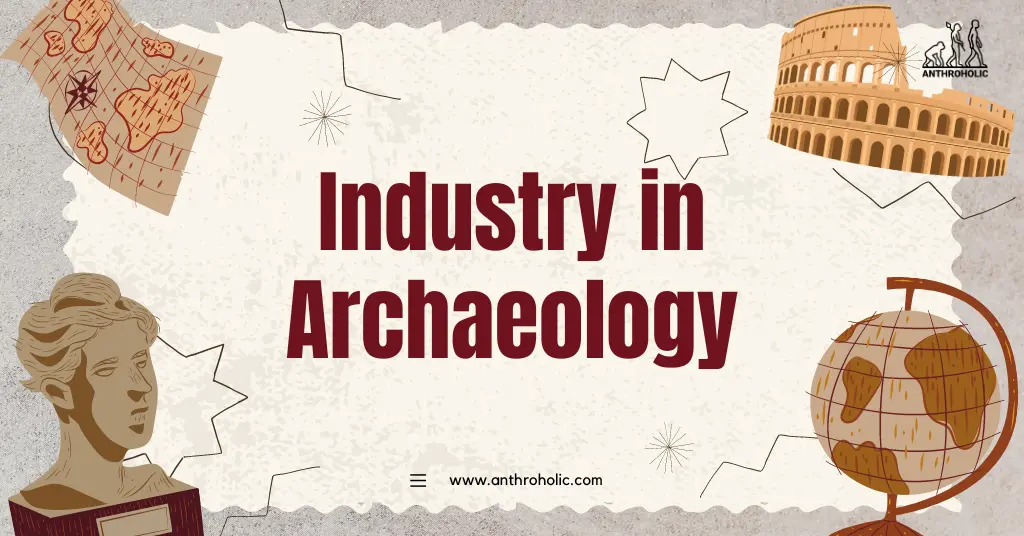AI Answer Evaluation Platform Live Now. Try Free Answer Evaluation Now
Industry in Archaeology
The term “industry” in archaeology refers to a category of artifacts that represent human-made or -modified objects, often characterized by function, style, and material. The industrial artifacts illustrate the breadth and depth of human activities, from primitive tool-making to complex metallurgical techniques [1].

The Significance of Industry in Archaeology
- The Insight into Societies: Industry offers a lens into the economic, social, and technological aspects of past societies. By studying the materials and methods employed, archaeologists can infer the knowledge, skills, and societal organization of these civilizations [2].
- Chronological Understanding: Industrial artifacts can often be used to date archaeological sites, contributing to the broader understanding of human history.
- Environmental Interaction: Industries reveal how societies interacted with their environments, utilizing available resources and shaping landscapes [3].
Key Industrial Artifacts
Several types of industrial artifacts and their archaeological significance are outlined below [4]:
- Lithic Artifacts: The earliest form of industry is seen in the creation of stone tools by hominins over 2.6 million years ago. These tools indicate the cognitive development of our ancestors and their adaptation to environments.
- Ceramic Industry: Ceramics are a window into a society’s culture, economy, and technological capabilities. They show a society’s advancement in firing techniques, decoration, and use of ceramics for various purposes.
- Metallurgy: Metallurgical artifacts reflect the discovery and utilization of metals such as copper, bronze, and iron. Each new metal discovery represented a significant societal and technological leap forward.
- Textile Industry: Textiles are rare due to their organic nature, but when found, they reveal vital information about a society’s agricultural practices, weaving techniques, and even trade routes.
| Industry Type | Major Archaeological Importance |
|---|---|
| Lithic | Insight into cognitive development, adaptation |
| Ceramic | Society’s culture, economy, technology |
| Metallurgy | Technological advancements |
| Textile | Agriculture, weaving techniques, trade |
Analyzing Industrial Artifacts
The analysis of industrial artifacts involves various methods, including:
- Typology: Classification of artifacts based on their characteristics. It aids in understanding their function and development over time.
- Use-Wear Analysis: Examining the wear on an artifact’s surface to infer its usage.
- Chemical and Physical Analysis: Techniques such as X-ray fluorescence (XRF) and neutron activation analysis (NAA) are used to determine the artifact’s composition, which can provide clues to its origin and production method.
Industry in Archaeology: A Deeper Look
Industrial Sectors in Archaeology
A few notable industrial sectors emerge within archaeological investigations. They often denote a high degree of specialization and societal advancement.
- Mining and Quarrying: Remains of mining and quarrying activities, like flint mines or stone quarries, reveal valuable information about resource extraction techniques, societal organization, and economic priorities of past societies.
- Craft Production: Craft production, such as bead-making, pottery, or metalwork, often signified specialized skills. This indicates the development of artisan classes and possibly early forms of market economies.
- Food Production: Millstones, grinding tools, and ovens show the evolution of food production. These artifacts offer insight into dietary habits, agricultural advancements, and domestication of plants and animals.
| Industrial Sector | Archaeological Significance |
|---|---|
| Mining and Quarrying | Insight into resource extraction techniques, societal organization |
| Craft Production | Indication of specialized skills, development of market economies |
| Food Production | Understanding of dietary habits, agricultural advancements |
Industrial Landscapes in Archaeology
Industrial activities often left substantial imprints on the landscape, forming what we term as ‘Industrial Landscapes’. The study of these landscapes presents a broader context for understanding industrial activities.
- Factories and Workshops: Archaeological remains of factories and workshops provide crucial information about the scale of production, workforce organization, and technological capabilities.
- Transportation Networks: Canals, roads, and tracks created for transporting goods or materials give insight into trade routes and the logistical capabilities of past societies.
- Resource Extraction Sites: Mining pits, quarries, and other extraction sites speak volumes about a society’s resource management and environmental impacts.
Industry and Society
Archaeological studies suggest strong ties between industry and society. For example, the advent of metallurgy led to social hierarchy, with metal workers holding a high status due to their specialized knowledge. Likewise, the textile industry often involved women, shedding light on gender roles in past societies.
Challenges and Future Perspectives
Despite their importance, industrial artifacts present several challenges:
- Preservation: Organic artifacts like textiles often do not survive in the archaeological record.
- Interpretation: Interpretations can be subjective, relying heavily on the archaeologist’s knowledge and assumptions.
In the future, technologies such as 3D scanning and AI could revolutionize artifact analysis, enabling more accurate interpretations and broadening our understanding of past industries.
Conclusion
Industry in archaeology provides a unique perspective into the lives of past societies, their technological capabilities, economic structures, and social organization. While the analysis of industrial artifacts poses some challenges, advancements in technology and analytical techniques promise exciting future insights.
References
[1] Renfrew, C., & Bahn, P. (2012). Archaeology: Theories, Methods, and Practice. Thames & Hudson.
[2] Trigger, B. (1989). A History of Archaeological Thought. Cambridge University Press.
[3] Butzer, K. W. (1982). Archaeology as Human Ecology. Cambridge University Press.
[4] Semaw, S. (2000). The World’s Oldest Stone Artefacts from Gona, Ethiopia. Journal of Archaeological Science, 27(12).




